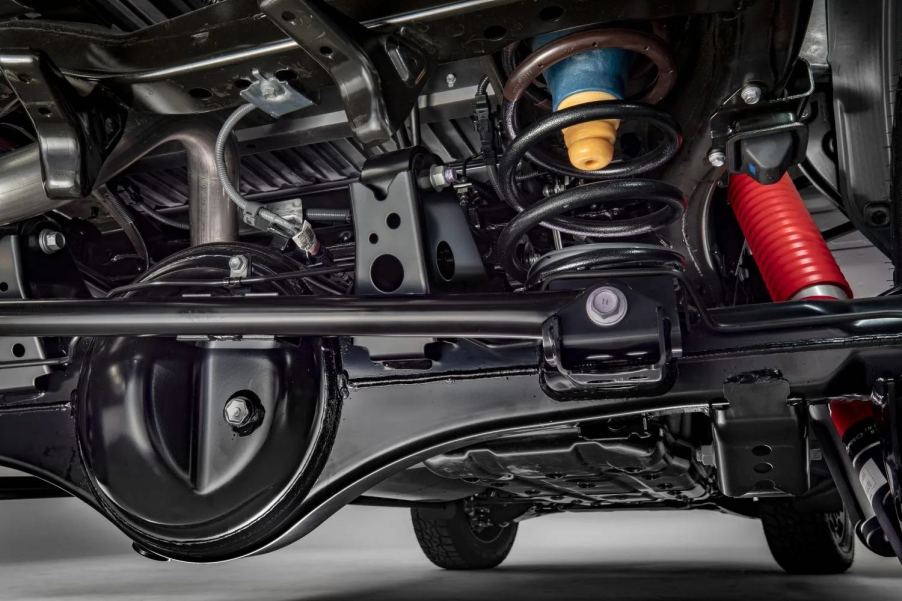
1 Full-Size Pickup Truck Tried Rear Coil Suspension, Then Went Back to Leaf Springs
The pickup truck world is divided. Full-size trucks from Ford, General Motors, and Nissan all still use rear leaf springs. Half-ton and 3/4-ton Ram pickups have been riding on rear coil springs since 2009, and the Toyota Tundra tossed its leaf springs in favor of coils for the 2022 model year. Some critics say the Chevrolet Silverado/GMC Sierra is just behind the times. But you might not know that these trucks pioneered rear coil spring suspension from 1960 through 1972. General Motors returned to rear leaf springs in 1973 for an unexpected reason.
The C/K ‘Action Line’ trucks (1960-72) boasted rear coil springs

For decades, General Motors’ pickup trucks shared a chassis with its cars. But in 1960, the automaker rolled out its first standalone truck/SUV chassis. Every new 2WD truck’s name started with a “C” followed by a weight rating number. Every 4WD got a K. For this reason, the new generation of trucks was dubbed the C/K truck line.
The C/K trucks’ suspension was years ahead of its time. These trucks all had independent front suspension instead of the standard beam front axle. They even featured front torsion bars until a 1963 redesign swapped these for front coils. In the back, the half-ton and 3/4-ton C/K trucks had rear-trailing control arms and coil springs. Finally, these trucks featured a drop-center frame to lower the cab and thus the center of gravity.
If you ordered a one-ton or heavier truck from Chevrolet or GMC, you got sturdier rear leaf springs. But for 12 years, most every truck General Motors made featured rear coil springs. The automaker ended up reverting to leaf springs for a surprising reason.
General Motors went back to rear springs with its 1973 ‘square body’ trucks

Chevrolet and GMC launched the third generation of their C/K truck series for the 1973 model year. This is nicknamed the “square body” generation and lasted until 1991. For 1973, Chevy and GMC quietly swapped back to rear leaf springs.
Some truck enthusiasts worry that while rear coil springs match leaf springs’ towing and payload capacities, they won’t prove as durable. The logic is that rear coil springs press against a single point of the frame and might wear through it in a rusty truck. On the other hand, leaf springs spread the truck’s weight along the frame’s length. But after just 12 years of rear coil springs, GM probably didn’t have enough ultra-high-mileage data to push it to return to leaf springs. So why did it revert to leaf springs?
In 1973, General Motors advertised its new rear suspension–with dual-stage “Vari-Rate” leaf springs and asymmetrical shock absorber geometry–as the “Load Control” system. Advertising materials specified that the new system was engineered to prevent wheel hop.
Wheel hop is a problem for an unloaded truck accelerating on uneven terrain. 1960s suspension technology may just not have been advanced enough to keep the rear wheels on the ground in such situations.
Not everyone agrees with the “wheel hop” claim
Some truck owners (such as members of the 67-72 Chevy Trucks forum) argue that General Motors returned to rear leaf springs just to save money. Ram and Toyota now build half-ton trucks with rear coil springs that suffer no increased “wheel hop.” Considering that General Motors hasn’t made any noise about bringing back rear coil springs, the cost-saving theory holds some water.
What do you think? Should General Motors have continued to offer GMC Sierras and Chevrolet Silverados with rear coil springs? Or was it wise to return to tried-and-true leaf spring technology? Let us know in the comments below.
Next, find out whether rear coil springs can handle heavy-duty hauling or learn more about the first-generation Chevrolet C10 in the video below:





